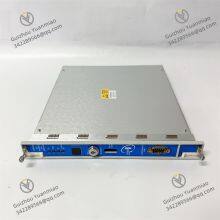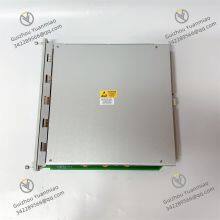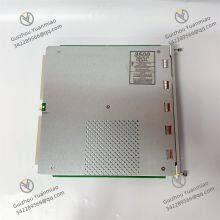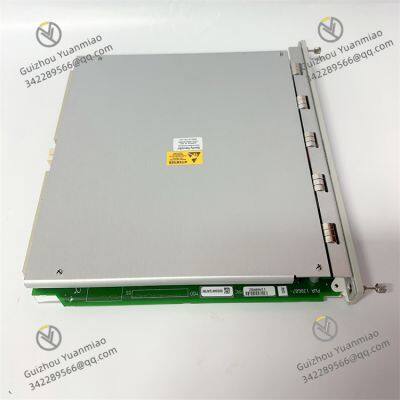I. Functional Features
Abundant Input Channels: The 138607-02 module is equipped with multiple data acquisition input channels, just like multiple information highways, which can simultaneously receive signals from various sensors, such as vibration sensors, displacement sensors, and speed sensors. This multi-channel design greatly expands the scope of data acquisition and enables synchronous monitoring of multiple key parts of industrial equipment. Taking large rotating machinery as an example, different channels can be connected to sensors at positions such as bearings, journals, and gearboxes respectively, collecting vibration, displacement, speed and other data during the operation of the equipment in an all-round way, providing a rich and detailed data basis for a comprehensive evaluation of the equipment status.
High-Speed Sampling: In view of the characteristics of transient data changing rapidly and having a short duration, the module has high-speed sampling capability, which can sample sensor signals at an extremely fast speed to ensure that every key transient information is captured. Whether it is the drastic changes at the moment when the equipment starts or stops, or the sudden abnormal fluctuations during operation, they can be accurately recorded. For example, when a generator set in the power industry starts, parameters such as voltage and current will have rapid transient changes. The 138607-02 module can complete the sampling of a large amount of data in a very short time, providing accurate data for analyzing the stability of the start-up process.
Steady-State Data Acquisition: During the normal operation of the equipment, the module can continuously and stably collect various operating parameters of the equipment, such as steady-state data like vibration amplitude, temperature, and pressure. These data are like the "routine physical examination indicators" of the equipment operation. Through long-term monitoring and analysis of them, we can understand the normal operating state range of the equipment and provide a benchmark for judging whether the equipment is abnormal. For pump equipment in chemical production, by continuously collecting its steady-state data such as vibration and temperature, we can timely detect signs of gradual deterioration of equipment performance due to wear, corrosion and other reasons.
Transient Data Capture: When transient events occur to the equipment, such as start-up, shutdown, sudden load change, and fault impact, the module will quickly switch to the transient data acquisition mode and accurately record the rapid change process of equipment parameters at these critical moments. These transient data contain important information such as changes in the internal structure of the equipment and potential faults, which are key bases for equipment fault diagnosis and performance optimization. In mechanical processing equipment, transient data such as the impact force generated at the moment when the tool contacts the workpiece can reflect the wear of the tool and the rationality of the processing technology. Through the analysis of these data, processing parameters can be adjusted in a timely manner to improve processing quality and efficiency.
Synchronous Waveform Data Sampling: To meet the needs of accurate monitoring of specific operating states of equipment, the 138607-02 module supports users to flexibly configure the synchronous waveform data sampling frequency. Users can choose different sampling configurations according to the operating characteristics and monitoring focuses of the equipment, such as various combinations like 1024 sampling points/revolution × 2 revolutions, 720 sampling points/revolution × 2 revolutions, etc. This synchronous sampling method can ensure that the collected data are accurately matched with the rotation cycle or specific operation cycle of the equipment, thus more clearly showing the state changes of the equipment in a complete operation cycle and providing strong support for analyzing the dynamic performance of the equipment. In wind turbine generators, by synchronously sampling and monitoring the vibration of blades in one rotation cycle, the dynamic balance state of the blades and the operating condition of the bearings can be effectively evaluated.
Asynchronous Data Sampling: In some cases, it is necessary to monitor random signals or wide-band signals during the operation of equipment. At this time, the asynchronous data sampling function of the module plays an important role. It can support 800-line spectrum sampling under different bandwidths, covering multiple frequency ranges from 10Hz to 30kHz, such as 10Hz, 50Hz, 1000Hz, 20kHz, etc. The data collected in the asynchronous sampling mode is processed by carefully designed anti-aliasing filtering, which effectively removes high-frequency noise interference and ensures the accuracy and reliability of the data. In the electromagnetic interference environment of industrial sites, asynchronous sampling combined with anti-aliasing filtering can accurately collect abnormal signals generated by equipment due to electromagnetic interference, providing data support for solving electromagnetic compatibility problems.
Multiple Communication Interfaces: To realize efficient data interaction with other equipment and systems, the 138607-02 module is equipped with a variety of communication interfaces. Among them, the Ethernet interface supports the 10Base-T/100Base-TX standard, follows the IEEE802.3 protocol, has high-speed data transmission capability, can be easily connected to the factory's local area network, and uploads a large amount of collected transient and steady-state data to the central monitoring system in real time, facilitating managers to view the equipment operation status remotely. At the same time, for some scenarios with high requirements for transmission distance and anti-interference, the module also provides a 100Base-FX Ethernet optical fiber interface, which adopts the IEEE802.3u protocol and is connected through an MT-RJ optical fiber connector. The maximum transmission distance can reach 400 meters (1312 feet), and multi-mode optical fiber ensures stable data transmission in complex electromagnetic environments. In addition, the module also supports the RS232 interface, adopts the BN host computer protocol, with a maximum baud rate of 115.2k baud (baud rate automatically adjusted), and a maximum cable length of 30 meters (100 feet). It can be connected with some traditional control equipment or monitoring instruments to realize two-way data transmission.
Wide System Compatibility: With excellent compatibility design, the module can be seamlessly integrated into various complex industrial automation system architectures. Whether it works in conjunction with BENTLY's own 3500 series monitoring systems (such as M series monitors like 3500/40M and 3500/42M) or is integrated with PLC and DCS control systems of other brands, it can be accurately adapted to jointly build a perfect equipment status monitoring and management system. In large-scale combined units of petrochemical enterprises, the 138607-02 module can closely cooperate with numerous sensors, controllers and upper computer systems to realize all-round monitoring and intelligent control of key equipment in the entire production process, ensuring the safety, stability and efficiency of the production process.
II. Technical Parameters
Operating Voltage: The module supports multiple power input modes to adapt to different industrial power environments. Specifically, they include 01 low-voltage AC (85-132VAC rms), 02 high-voltage AC (175-264VAC rms), 03 high-voltage DC (88-140VDC), 04 low-voltage DC (20-30VDC), and 05 universal AC power supply (85-264VAC rms) (new model). The rich power options enable the module to be easily connected to various industrial power systems, realize power sharing with other equipment using the same voltage level, and reduce the complexity and cost of system power configuration. At the same time, regardless of the power input mode chosen, a stable supply voltage provides a solid power guarantee for the reliable operation of the module.
Input Impedance: The standard I/O input impedance is carefully designed to be 10kΩ, which can perfectly match mainstream sensors on the market. When the sensor outputs a signal, it ensures that the signal can be efficiently and stably transmitted to the module for subsequent processing, avoiding signal attenuation or distortion caused by impedance mismatch, thus ensuring the accuracy of monitoring data. In practical applications, whether connecting high-precision vibration sensors or other types of sensors such as displacement and pressure sensors, the 10kΩ input impedance can play an excellent adaptation role, ensuring the quality of signal transmission.
Power Consumption: While meeting the needs of powerful monitoring functions, the 138607-02 module maintains a low energy consumption level, with a power consumption of only 7.7W. The low-power characteristic not only helps reduce the overall operating cost of industrial equipment and energy consumption, in line with the development trend of energy conservation and emission reduction in modern industry, but also effectively reduces the heating problem during equipment operation. Lower heat generation is conducive to improving the stability and reliability of the module, extending the service life of the equipment, and reducing the probability of failures caused by overheating, especially in industrial scenarios with long-term continuous operation, the advantage of low power consumption is more obvious.
Dimensions: The module adopts a compact modular design concept, with an external dimension of 242mm × 25mm × 100mm. Its small size enables it to easily find a suitable installation position when the internal space of the equipment is limited, without occupying too much valuable equipment space. Whether it is installed in a control cabinet, arranged compactly with other control modules, or integrated into a small space of the equipment, such as installed inside some precision mechanical equipment with strict space requirements, it can handle it with ease, providing convenience for the miniaturization and integration design of industrial equipment, and will not limit the overall layout of the equipment due to its own size.
Weight: It weighs about 0.20kg (0.44lbs). The light weight has significant advantages during equipment installation. On the one hand, it is convenient for installers to carry and operate, reducing the labor intensity of installers and improving installation efficiency, especially in maintenance scenarios where frequent installation and disassembly of modules are required, the light weight makes the operation more convenient. On the other hand, during the operation of the equipment, such a light module will not impose additional burdens on the structural stability of the equipment, ensuring that the equipment can run smoothly, and will not affect the dynamic performance of the equipment due to the weight of the module, which is particularly suitable for some industrial application scenarios that are sensitive to vibration and have strict requirements on the overall weight of the equipment.
Protection Level: The protection level reaches a high standard. Although the specific value is not clearly specified, judging from its application scenarios and design considerations, it has good dustproof and waterproof capabilities. This means that even in harsh industrial environments such as dusty and humid ones, such as underground coal mines, chemical workshops, and textile factories, the electronic components inside the module can be reliably protected. It effectively prevents the intrusion of foreign objects such as dust and water vapor, avoids failures such as short circuits and corrosion of electronic components caused by harsh environmental factors, ensures the stable operation of the module in complex environments, extends the service life of the module, and reduces equipment maintenance costs and downtime caused by environmental factors.
Speed Range Support: The speed range supported by the module is closely related to the number of active dynamic channels. Its excellent design can adapt to the monitoring needs of equipment with different speeds, from large mining machinery running at low speeds to precision machine tool spindles rotating at high speeds, all can be accurately monitored. In practical applications, whether for low-speed equipment with tens of revolutions per minute or high-speed equipment with thousands or even tens of thousands of revolutions per minute, the 138607-02 module can stably collect relevant data according to the equipment speed characteristics and dynamic channel configuration, providing an accurate basis for the analysis of equipment operating status.
Event Input Capability: It supports multiple event inputs per revolution, with a maximum of 20kHz. This powerful event input capability enables the module to Acute ly capture multiple key events occurring in each rotation cycle of the equipment. For example, in a gear transmission system, when a gear has faults such as wear and cracks, it will generate impact signals of specific frequencies during rotation. The module can accurately record these impact events with its high event input frequency, and quickly judge the fault type and severity of the gear through the analysis of the events, providing key clues for equipment maintenance.
Speed Interval Programming: During the acceleration and deceleration phases of the equipment, the module allows users to independently program the speed interval. Users can flexibly set the speed monitoring intervals in different phases according to the actual operating process requirements of the equipment. During the motor start-up process, since the speed changes rapidly, a smaller speed interval can be set to collect data more densely and accurately monitor abnormal conditions during the start-up process; while in the stable operation phase of the equipment, the speed changes relatively small, so the speed interval can be appropriately increased to optimize data collection efficiency, reducing the pressure of data storage and transmission while meeting the monitoring needs.
Speed Detection Window: The module can detect the machine speed in one of the two programmable windows. When the equipment speed enters the preset detection window, it will automatically activate the transient data acquisition function. By reasonably setting these two detection windows, it can ensure accurate collection of transient data in the key speed intervals of equipment operation, such as the critical speed region during start-up and shutdown processes, and the speed change interval when the equipment switches between different working conditions. During the start-up process of a steam turbine, when the speed is close to the critical speed, parameters such as equipment vibration will change drastically. By setting an appropriate detection window, the module can timely capture the transient data in this critical phase, providing important data support for analyzing the start-up stability and safety of the steam turbine.
Transient Data Storage: The amount of transient data collected is only limited by the available storage space in the module, which provides a guarantee for long-term and large-scale collection of transient data. 20 seconds before and 10 seconds after the event occurs, the module can record data at 100-millisecond intervals, completely retaining the change process of the equipment status before and after the event. When a sudden equipment failure occurs, the data in this time period is of great value for analyzing the cause of the failure and judging the development process of the failure. In addition, 2.5 minutes before and 1 minute after the alarm, the module can also record waveform data, providing rich waveform information for further in-depth analysis of abnormal equipment status, helping technicians more intuitively understand the changes in the operating status of the equipment before and after the failure.
Static Value Provision: TDI (Transient Data Interface, i.e., the functions related to the 138607-02 module) provides 4 nX static values for each monitoring point, and these static values can be used as important reference indicators for the equipment operating status. Through long-term monitoring and analysis of these static values, the slow change trend of the equipment operating status can be found, such as the gradual wear and aging of equipment components, early warning of potential faults, and providing a scientific basis for preventive maintenance of the equipment. In industrial production, through the analysis of the static values of monitoring points in key parts of the equipment, signs of deterioration of equipment performance can be found in time, and maintenance plans can be arranged in advance to avoid production interruption caused by sudden equipment failures.
Waveform Data Acquisition: The module has a powerful waveform data acquisition capability, which can collect waveform data of up to 48 channels at the same time. The rich number of channels enables synchronous waveform monitoring of multiple key parts of the equipment, comprehensively grasping the operating status of the equipment. In large generator sets, vibration waveform data of multiple positions such as bearings and journals can be collected at the same time. By comparing and analyzing the waveform characteristics of different channels, problems such as equipment imbalance, misalignment, and bearing failure can be accurately judged, providing comprehensive and accurate data support for equipment fault diagnosis.
Operating Temperature Range: The operating temperature range is -30℃ to +65℃ (-22°F to +149°F), and some data mention that in certain application environments, the temperature range can be extended to -40℃ to +70℃ (-40°F to +158°F). Such a wide operating temperature range enables the module to adapt to extreme temperature environments from cold northern industrial areas to hot southern factory workshops, and even some high-temperature industrial production sites such as metallurgy and glass manufacturing. In severe cold conditions, the electronic components inside the module, after special design and selection, can still maintain stable working performance and will not cause circuit failures due to low temperatures; in high-temperature environments, through reasonable heat dissipation design and selection of high-temperature resistant materials, the module can be ensured to operate normally, continuously providing reliable monitoring services for the equipment without being affected by temperature changes.
Storage Temperature Range: The storage temperature range is -40℃ to +85℃ (-40°F to +185°F), which ensures that the module will not suffer permanent damage to its performance even if it experiences extreme temperature environments during transportation, storage and other non-working states. During low-temperature transportation in winter or storage in high-temperature warehouses, the module can maintain a good performance state, and when put into use again, it can still operate stably, providing reliable guarantee for industrial equipment monitoring.
Humidity Range: It can work stably in an environment with a relative humidity of up to 95% (non-condensing), and has good adaptability to humidity environments. Whether in industrial facilities in arid desert areas, factories in humid coastal areas, or some production workshops with high humidity, such as food processing and papermaking industries, the module can effectively resist the impact of humidity changes on its performance. By adopting moisture-proof and anti-corrosion circuit board design and component packaging technology, it prevents problems such as short circuits and corrosion of electronic components caused by high humidity, ensures long-term stable operation of the module, and reduces equipment failures and maintenance costs caused by humidity factors.
















































